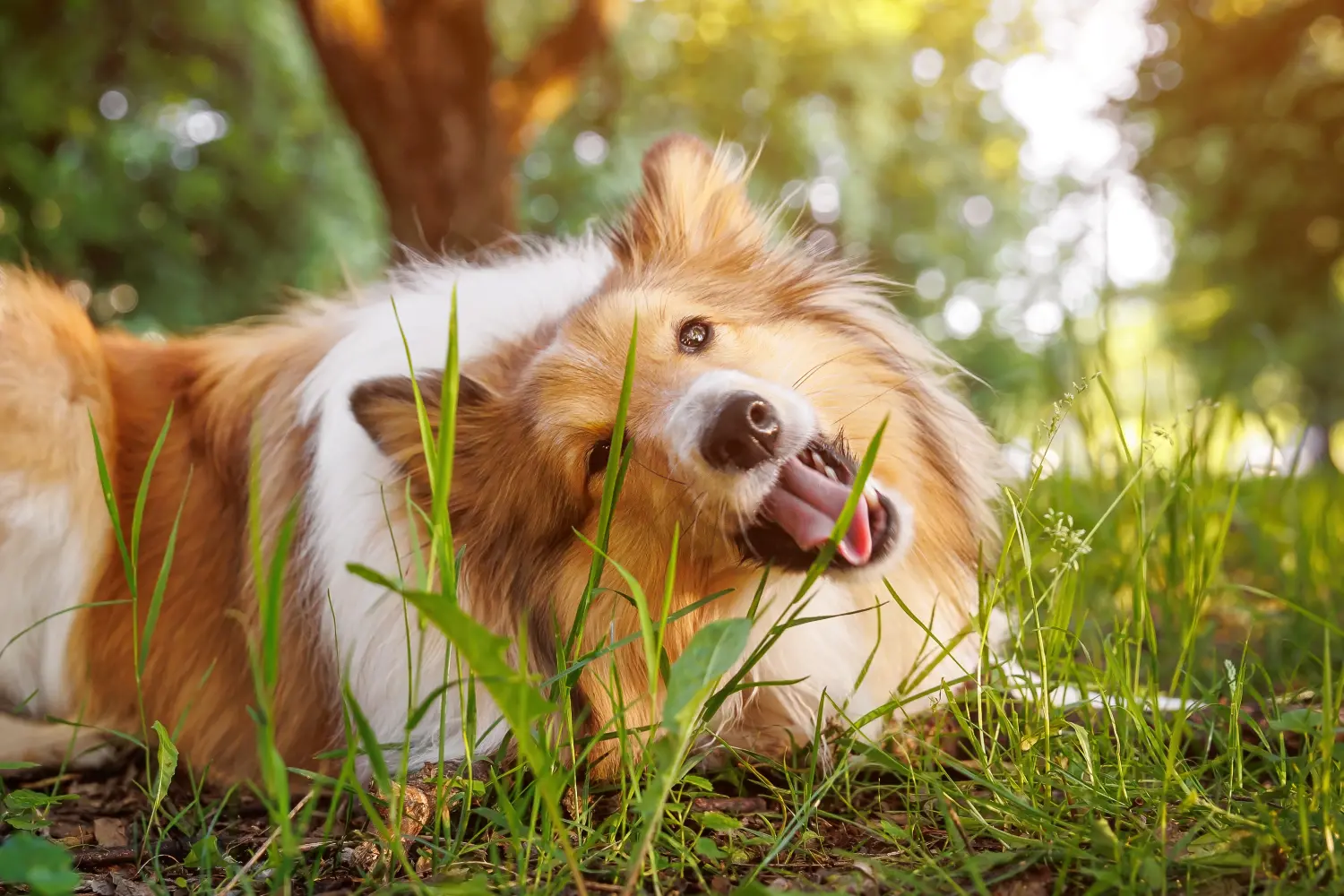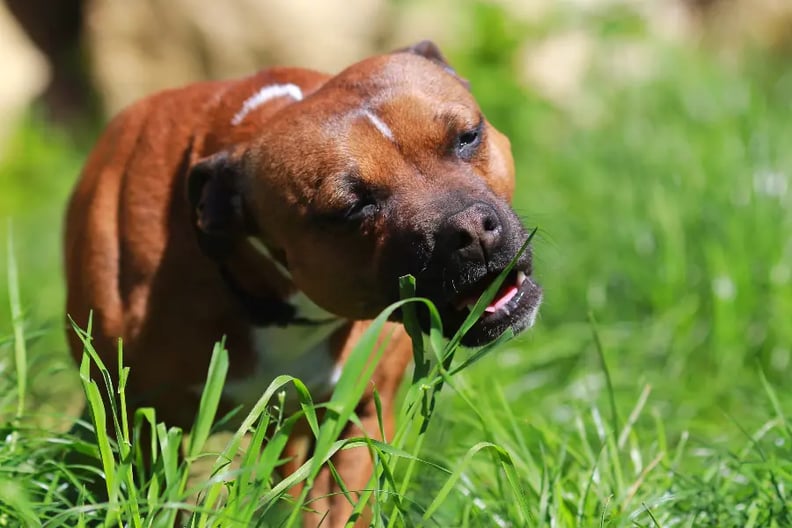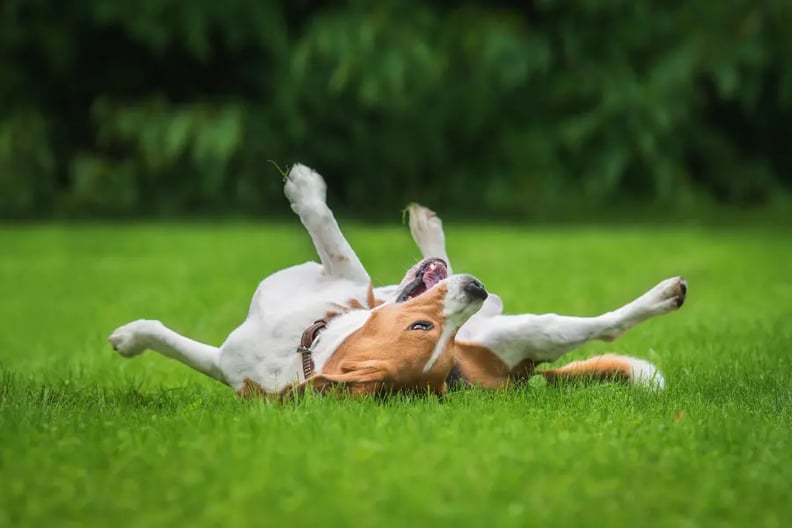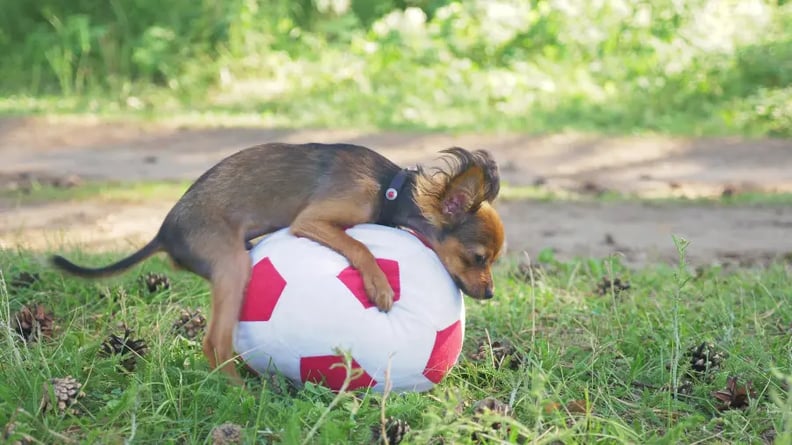
Does your dog love eating grass? It's a common behaviour, but is it safe and why do dogs eat grass? We'll break down the reasons your dog might be inclined to nibble on your lawn and a few other quirky dog behaviours.
Dogs do weird stuff sometimes. Whether they are licking windows, chasing their own tail, or barking at themselves in the mirror, dogs are amusingly quirky. But not every strange dog habit is safe, and some could be a sign of a bigger health or behavioural problem.
5 Reasons Why Dogs Eat Grass?
You've probably seen your dog snacking on grass before, but why do they do it? Is it a vestige of their wild ancestry, a sign of illness, or simply a quirk of individual preference?
There could be multiple reasons your dog has a taste for greenery, and understanding these reasons can help you determine if your dog's grass addiction is safe or suspicious. Here are the most common causes of grass eating in dogs:
1. Instinct - Your dog's wild ancestors commonly ate grass and other vegetation when they needed to. As scavenging carnivores, they ate whatever food was available. In this context, the consumption of grass and other vegetation was not only common but perhaps essential for survival.
While the domestic dog's diet takes a meat-first approach, evolutionary echoes of their ancestors can manifest as occasional grass consumption in modern-day pups.
2. Nutritional Deficiencies - One of the more common beliefs is that dogs seek out grass as a means of satisfying a potential nutrient deficiency. It may seem far-fetched to think that dogs could recognize and seek to correct nutritional imbalances, but it's a habit based on instinct.
Grass contains a variety of vitamins, minerals, and fibre that could offer valuable nutrients missing from their regular diet or could aid in recovery when your dog is feeling unwell. Grass eating is a good indicator that you may need to assess your dog's diet and overall health with your vet.
3. Digestive Aid - One of the prevailing theories surrounding grass-eating behaviour in dogs centers on its purported role as a digestive aid. When dogs experience gastrointestinal discomfort, such as nausea or indigestion, they may instinctively turn to grass as a natural remedy. The rough texture of grass can help stimulate the throat and stomach lining, triggering regurgitation and facilitating the expulsion of irritants or toxins.
4. Bored or Anxiety - Eating grass could simply be a behavioural issue that results from dog boredom or anxiety. If your dog is understimulated, spends too much time alone, or is generally nervous, they will seek to express their feelings or fill their time with an activity that makes them feel better.
Though grass eating may not seem overly entertaining or tasty, it could be just enough to relieve stress and boredom temporarily. Fortunately, this bad habit can be easily replaced with positive and safe activities, like chew toys or bully sticks.
5. They Like How it Tastes - Let's not overlook the possibility that some dogs simply enjoy the taste or texture of grass. Dogs experience the world through their senses, including taste and touch, and grass may offer a novel sensory experience or a satisfying chewing outlet.
Additionally, individual dogs may develop preferences for specific types of grass based on factors such as texture, scent, or flavour, further influencing their grass-eating behaviour.
Is it Safe for Dogs to Eat Grass?

The good news is that occasional grass consumption is generally considered harmless and even normal behaviour for many dogs. So long as the grass is not chemically treated and is not part of a garden with potentially toxic plants, then don't worry about it.
Excessive or compulsive ingestion of grass or other greenery, on the other hand, is not only indicative of a problem but can in itself be dangerous.
Pet owners should monitor their dogs' when outdoors to watch for signs of eating grass, dirt, or other random things off the ground and be vigilant for signs of underlying health issues or dietary imbalances.
Solutions for Dogs Who Eat Grass
The best solution will depend on the cause, but a good place to start is by assessing their overall health and their diet. Dogs who eat a high-quality and balanced diet are less likely to seek out additional nutrients or fibre from grass.
Make sure your dog's diet is made from real and natural food ingredients and contains plenty of healthy animal protein to provide a full spectrum of essential amino acids and other nutrients. Meal boosters, like Flora4, kelp, and goat's milk can all help buffer your pet's diet and ensure adequate nutrients.
Behavioural training is also a key step in reducing or eliminating the problem of grass eating in dogs. Providing a consistent and exciting routine of exercise, playtime, and one-on-one interaction can reduce bored or anxious reactions that could lead to destructive behaviours.
Safer Options for Dogs That Eat Grass
If your dog eats grass because he loves the taste or if you suspect they are trying to correct a nutrient deficiency, then try offering them some homegrown oat grass.
Although commonly marketed towards cats to help relieve hairballs and improve digestion, wheatgrass or cat grass is packed with vitamins and minerals that can both satisfy your dog's grass-eating desires and boost their nutrition. Make sure you are monitoring your dog's grass-eating habits, and offering it to them in a safe quantity.
Why Do Dogs Roll in Smelly Things?

If your dog likes to use garbage, poop, or other gross things as cologne, then you might be wondering why and how to put a stop to this unpleasant habit. The result is pretty nasty, but the reason is quite logical. At least to your dog.
Your dog's nose is his most important tool for understanding and exploring his environment, and when they catch a hint of an interesting smell, there are a few common reasons that they choose to roll around in it.
Pride - If your dog comes across a particularly interesting, potent, or even noxious smell, they will want to show off their discovery. Rolling in the smell can help them carry the odour around with them, alerting other animals that they found something cool and that they are a good dog.
Survival Instinct - In the wild, dogs have to be vigilant of potential predators, and rolling in a strong odour can help them mask their own scent and pheromones. Disguising their own smell can help them feel safe and reduce anxiety.
How to Get Your Dog to Stop Rolling in Smelly Things
The majority of new and interesting smells will be discovered outside of your dog's regular environment. This means your dog is more likely to roll in something gross when you are out on a walk or hike.
The best way to put an end to their disgusting potpourri is to keep them on leash and keep a close eye. Walking gear like a dog harness will give you better control. Look for a harness with a handle to try a traffic control leash to allow you to quickly move your dog if they find an enticing smell.
If your dog's smelly habit stems from a fear of predators, consider walking them in low-traffic areas or stick to areas with minimal wild animal activity. The fewer potential predators, the less likely your dog will feel the need to mask their scent.
Why Do Dogs Chase Their Tails?

Some dogs like to chase their own tail, and the lucky ones never catch it. Buy why? Dogs chase their tails for a variety of reasons, and the behaviour can indicate different things depending on the context.
Here are some possible reasons why dogs chase their tails:
It's Fun! - Dogs, especially puppies, may chase their tails as a form of play. They might see their tail as a fun thing to chase, similar to how they might chase a toy or a ball. It can also be an expression of excitement. This can be seen as a reaction to anticipation of something they enjoy, like food or a walk.
Exercise - Another common reason for tail chasing in dogs may be to release excess energy and get some exercise, especially if they are bored or not getting enough physical activity. This may be a sign of frustration or anxiety too.
Curiosity - Some dogs may chase their tails out of curiosity, especially if they are young and still exploring their bodies and the world around them. The quick flicks of the tail can easily catch your dog's attention, without them realizing it's their own tail until they catch it.
Attention-seeking - Much like barking, jumping, and nipping, tail chasing can be a way for dogs to get attention from their owners, especially if they have learned that this behaviour gets a reaction. They chase, you laugh, and the behaviour is then encouraged.
Medical issues - In some cases, tail chasing can be a sign of a medical issue, such as fleas, allergies, or an injury. It's important to rule out any underlying health problems if your dog is chasing its tail excessively or aggressively.
Understanding the reasons behind it can help you determine if your dog's tail obsession is safe and fun or indicative of an issue. In most cases, tail chasing is nothing more than quirky dog behaviour. It's harmless and entertaining.
If your dog is chasing its tail excessively or if the behaviour is accompanied by other concerning symptoms, such as biting or licking at the tail, it's a good idea to consult with a veterinarian or a professional dog trainer to determine the underlying cause and address any potential issues.
Why Do Dogs Hump?

One of the funnier and also more nuisance dog behaviours that make us wonder what is going through their fuzzy little heads is humping. If your dog is a humper, then you know that it's a party trick that gets old fast.
Learn why your dog likes to express himself so sensually and tips for getting them to knock it off.
Hormones - Hormones can significantly affect behaviour, and for growing puppies, hormone changes are common. Both male and female dogs can develop some randy behaviours before they reach maturity. Spaying or neutering puppies at the appropriate age may help reduce these urges, but training and a consistently engaging routine are the most effective ways to curb this behaviour.
Asserting Dominance - Another reason that dogs may hump is to assert dominance or display aggression. This type of behaviour is more often seen in dog-to-dog interactions, but some dogs will hump to assert dominance over children and even adults.
Overstimulation - Humping can also be a way for dogs to express excitement and overstimulation. This could be triggered by being in a new place with unfamiliar people, pets, or smells. If your dog is overstimulated by a new, loud, or busy environment, they will seek out a physical way to express their excitement, and in some cases, this means humping.
How to Discourage Dog Humping
Regardless of the cause of your dog's humping, the best solution is to replace this behaviour with a healthier and safer activity. Training your dog to redirect his behaviour towards a dog chew toy, an interactive game, or a natural chew can help your dog break this unsavoury habit.
A consistent and enriching routine is the best way to prevent and reduce unwanted behaviours in dogs. They need to be both physically and mentally stimulated by offering regular exercise, fun games, daily training, and positive reinforcement.
Dogs Are Weird, But That's Normal
In the intricate tapestry of canine behaviour, habits like eating grass or dirt, tail chasing and humping are among some of the most common. Whether the cause is behavioural, health-related, or just a complete mystery, the most important thing is to understand when a weird dog behaviour is safe and when it's time to intervene.
Even as we shed light on the motivations behind dog behaviour, we must acknowledge that there is still much we do not fully understand. Dogs, like humans, are individuals with unique preferences, experiences, and personalities, and their motivations for many habits, like eating grass, may vary widely from one dog to another.
Some may do it out of instinctual drive, while others may simply find pleasure in the act itself. As long as your dog's behaviour is not harmful to themselves or anyone else and you've ruled out a medical cause, let them be goofy and explore the world how they feel comfortable.
.png?width=200&height=66&name=logo%20(1).png)


.jpg)
